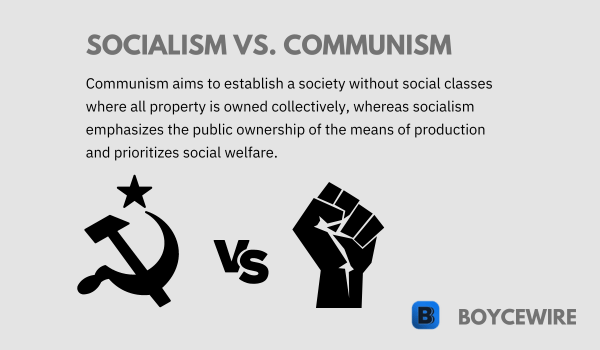Socialism vs Communism

Introduction
Socialism and Communism are often used interchangeably to describe economic systems that challenge the principles of capitalism. However, while they share some similarities, they are distinct ideologies with their own unique histories, principles, and goals.
This article seeks to demystify the differences and similarities between Socialism and Communism, providing readers with a deeper understanding of these economic systems.
Key Points
- Socialism and communism share similarities, such as advocating for collective ownership of the means of production and a more equitable distribution of wealth. However, communism is a more radical form of socialism.
- The fundamental principles of socialism include collective ownership, reducing income inequality, and significant government involvement in the economy. Communism, on the other hand, calls for the abolition of private property and class distinctions, centralized control of the means of production, and the goal of a classless, stateless society.
- The economic structures of socialism and communism differ, with socialism allowing for a mix of market mechanisms and government intervention, while communism seeks to establish a centrally planned economy and eliminate market forces.
- Socialism encompasses a range of political systems, from democratic socialism to more authoritarian regimes. Communism has historically been characterized by single-party rule and authoritarian governance.
Summary of Comparisons
| Socialism | Communism | |
|---|---|---|
| Ownership of the means of production | Public ownership of major industries; worker cooperatives; mixed economy | Collective ownership of all property; no private property |
| Social classes | Reduced or eliminated through equal opportunities and benefits | No classes; society is classless and equal |
| Role of the government | Active role in managing the economy and providing social services; democratic socialism | No government, or minimal government intervention; anarchism |
| Income distribution | More equal, but not necessarily equal; progressive taxation and social welfare programs | Equal; no individual ownership of property or means of production |
| Property rights | Individuals have the right to own personal property; major industries and means of production are owned by the state or workers | No private property; all property is owned by the community or state |
| Class struggle | May exist but is minimized through social welfare programs and labor protections | Is central to revolutionary change; overthrow of capitalist class by the proletariat |
| Revolutionary tactics | May use peaceful or democratic means to achieve change | Requires violent revolution to overthrow the capitalist state |
| Implementation in practice | Various forms of socialism have been implemented in several countries, but with mixed success | Attempts to implement communism in practice have resulted in authoritarian regimes and widespread human rights violations |
1. Historical Background
Both socialism and communism emerged in response to the social and economic upheavals of the 18th and 19th centuries, particularly the Industrial Revolution.
These ideologies sought to address the growing income inequality, exploitation of workers, and concentration of power that accompanied the rise of capitalism. However, their origins and development paths were distinct, with socialism predating communism and evolving through various thinkers and movements.
Origins of Socialism
Early socialist ideas can be traced back to the works of utopian socialists like Charles Fourier, Henri de Saint-Simon, and Robert Owen, who envisioned cooperative societies where resources were shared more equitably, and people lived in harmony.
Their ideas were largely a response to the social dislocation and poverty resulting from the rapid industrialization and urbanization of the early 19th century.
The Industrial Revolution, with its mass production and division of labor, spurred further development of socialist thought. As wealth inequality widened and the working conditions for laborers deteriorated, calls for social and economic reforms grew louder. This led to the emergence of more radical and revolutionary socialist thinkers, such as Pierre-Joseph Proudhon and Mikhail Bakunin.
Origins of Communism
Communism finds its roots in the works of German philosophers Karl Marx and Friedrich Engels, who built upon earlier socialist ideas but sought a more radical and comprehensive transformation of society.
In 1848, Marx and Engels published “The Communist Manifesto,” which laid out the principles of communism and provided a critique of capitalism. They argued that capitalism was inherently exploitative and would eventually lead to its own demise, giving way to a classless, stateless society.
Marx and Engels viewed communism as the final stage in human social evolution, following feudalism and capitalism. They believed that a global proletarian revolution would overthrow the capitalist class, establish a dictatorship of the proletariat, and eventually lead to a classless, communist society.
Socialism and communism continued to evolve and diverge throughout the 19th and 20th centuries, with various political movements and leaders adopting different interpretations and strategies.
The Russian Revolution of 1917 marked a turning point, as Vladimir Lenin and the Bolsheviks seized power and established the world’s first communist state, the Soviet Union. This event had a profound impact on the global socialist and communist movements, leading to further divisions and ideological debates.
2. Fundamental Principles
Communism and socialism share some similarities, as both ideologies emphasize collective ownership of the means of production and advocate for a more equitable distribution of wealth. However, their fundamental principles differ in terms of their goals, methods, and the extent of government involvement in the economy.
Fundamental Principles of Socialism
- Collective ownership Socialism calls for the means of production, such as factories, land, and resources, to be owned collectively or by the state. This is intended to prevent exploitation by private owners and ensure a more equitable distribution of wealth.
- Reducing income inequality Socialists aim to reduce income inequality through wealth redistribution, progressive taxation, and the provision of public services like healthcare, education, and social welfare programs.
- Government involvement Socialism generally supports a significant role for the government in managing the economy. This can take various forms, from regulating industries and setting minimum wages to directly owning and operating key industries.
Fundamental Principles of Communism
- Abolition of private property and class distinctions Communism seeks to completely abolish private property and the class system, viewing them as the root causes of exploitation and inequality. It calls for the communal ownership of all resources, with each person contributing according to their ability and receiving according to their needs.
- Centralized control of the means of production Under communism, the state takes direct control of the means of production, eliminating the role of private owners and market forces. This centralized approach is intended to ensure that resources are allocated efficiently and equitably, with production geared toward meeting the needs of the entire population.
- Goal of a classless, stateless society The ultimate goal of communism is to achieve a classless, stateless society where exploitation and oppression have been eradicated. This involves the dismantling of the state apparatus, as the need for government coercion and control would become obsolete in a truly communist society.
In summary, socialism and communism share some common principles, such as collective ownership of the means of production and a focus on reducing income inequality. However, communism is a more radical form of socialism that seeks to abolish private property, class distinctions, and ultimately the state itself. Socialism allows for various degrees of government involvement and often includes market mechanisms, while communism calls for a centrally planned economy and the complete elimination of market forces.
3. Economic Structures
Communism and socialism both aim to establish more equitable economic systems, but they differ significantly in their approaches to organizing and managing economies. These differences are evident in their respective economic structures, which include the roles of markets, government intervention, and resource allocation.
Economic Structures of Socialism
- Market socialism and planned socialism Socialism encompasses a range of economic systems that combine elements of both market forces and government planning. Market socialism allows for market mechanisms to determine prices and allocate resources, while the government maintains control over key industries. In planned socialism, a central planning body is responsible for controlling the economy and distributing resources according to a comprehensive plan.
- Role of the government In a socialist economy, the government plays a significant role in regulating industries, ensuring a more equitable distribution of wealth, and providing public goods and services. This can involve direct ownership and operation of key industries, such as utilities, transportation, and healthcare, or indirect control through regulations and subsidies.
Economic Structures of Communism
- Centrally planned economy Communism calls for a centrally planned economy, in which the state determines production levels, sets prices, and allocates resources based on a comprehensive plan. This approach seeks to eliminate the influence of market forces and ensure that resources are allocated efficiently and equitably to meet the needs of the entire population.
- Elimination of market forces and currency In a communist economy, market forces and currency are abolished. The state is responsible for providing goods and services to the population according to their needs, and labor is performed for the common good. This is intended to prevent exploitation and create a society where resources are shared without the need for financial transactions or profit motives.
In summary, the economic structures of socialism and communism differ in their approaches to organizing and managing economies. Socialism allows for a mix of market mechanisms and government intervention, with varying degrees of state control over industries and resource allocation.
Communism, on the other hand, seeks to establish a centrally planned economy, in which the state controls all aspects of production and distribution and market forces are eliminated. The goal of both systems is to create a more equitable distribution of wealth and resources, but they differ significantly in their methods and structures.
4. Political Systems
Communism and socialism have distinct political systems that correspond with their respective economic structures and goals. While both ideologies advocate for more equitable societies, they diverge in their approaches to governance, political power, and democratic processes.
Political Systems of Socialism
- Democratic socialism Democratic socialism is a form of socialism that combines socialist economic principles with democratic political processes. It emphasizes worker participation, social justice, and democratic decision-making in both the economy and the political sphere. Examples of democratic socialist parties can be found in various countries, such as the Labour Party in the United Kingdom and the Social Democratic Party in Germany.
- Authoritarian socialism In some cases, socialist governments have taken a more authoritarian approach to governance, centralizing power and suppressing political opposition. These systems often prioritize the achievement of socialist goals over individual liberties and democratic processes. Examples of authoritarian socialist governments include the Soviet Union under Joseph Stalin and Cuba under Fidel Castro.
Political Systems of Communism
- Single-party rule Communist political systems have historically been characterized by single-party rule, in which the communist party holds a monopoly on political power. This centralization of power is often justified as a necessary step to achieve the ultimate goals of communism, such as the abolition of class distinctions and the establishment of a classless, stateless society.
- Authoritarian governance Communist regimes have typically been associated with authoritarian governance, in which dissent and opposition are suppressed in the name of maintaining control and pursuing the goals of communism. This has led to widespread concerns about human rights and individual freedoms in communist states. Examples of authoritarian communist regimes include the Soviet Union under Stalin, China under Mao Zedong, and North Korea under the Kim dynasty.
In conclusion, socialism and communism differ in their political systems, with socialism encompassing a broad range of political structures, from democratic socialism to more authoritarian regimes.
Communism, on the other hand, has historically been characterized by single-party rule and authoritarian governance. These differences in political systems reflect the distinct goals and methods of each ideology, with socialism allowing for varying degrees of government involvement and democratic processes, while communism seeks to centralize power and eliminate class distinctions and private property.
5. Real-World Examples
Real-world examples of communism and socialism help illustrate the differences and similarities between these two economic and political ideologies in practice. Here are some notable examples from history and contemporary times:
Real-World Examples of Socialism
- Nordic countries Countries like Sweden, Norway, Denmark, and Finland are often cited as examples of successful democratic socialist systems. These countries have high levels of government intervention in the economy, including strong social welfare programs, universal healthcare, free education, and strong labor protections. At the same time, they also maintain market economies and democratic political systems.
- United Kingdom (1945-1979) After World War II, the Labour Party in the UK implemented various socialist policies, such as nationalizing key industries (e.g., coal, steel, rail, and utilities) and expanding the welfare state. These policies aimed to reduce income inequality and provide public goods and services. The UK moved away from socialism during the 1980s under the leadership of Prime Minister Margaret Thatcher, who pursued free-market policies and privatization of state-owned enterprises.
Real-World Examples of Communism
- Soviet Union (1922-1991) The Soviet Union, led by the Communist Party of the Soviet Union, was the world’s first communist state. It followed a centrally planned economic model, with the state owning and controlling all means of production. The Soviet Union experienced significant industrial and military growth during its existence but faced economic stagnation and collapse in the late 20th century. The USSR was also an authoritarian regime with widespread suppression of political dissent and human rights abuses.
- China (1949-Present) The People’s Republic of China was established as a communist state in 1949 under the leadership of Mao Zedong. China pursued a radical form of communism during Mao’s reign, marked by events like the Great Leap Forward and the Cultural Revolution, which resulted in widespread famine, economic turmoil, and human rights abuses. Since the late 1970s, China has undergone market-oriented reforms and incorporated elements of capitalism into its economy, while still being governed by the Communist Party. Contemporary China represents a unique blend of socialism, communism, and state-controlled capitalism.
- Cuba (1959-Present) After the Cuban Revolution in 1959, Fidel Castro established a communist government in Cuba. The Cuban economy became centrally planned, with the state controlling all major industries. Cuba has faced significant economic challenges, including a long-standing trade embargo by the United States. Despite these challenges, Cuba has managed to maintain a robust healthcare and education system. The Cuban government has also been criticized for its suppression of political dissent and lack of democratic processes.
These real-world examples demonstrate the diverse ways in which socialism and communism have been implemented throughout history and around the world. They highlight the differences in economic structures, political systems, and outcomes associated with each ideology, while also illustrating how both systems have evolved and adapted to changing circumstances.
6. Criticisms and Challenges
Both communism and socialism have faced various criticisms and challenges, with detractors pointing to economic inefficiencies, political repression, and other issues that have arisen in countries implementing these systems. Here are some common criticisms and challenges associated with each ideology:
Criticisms of Socialism
- Inefficiencies in resource allocation Critics argue that socialism, particularly in its centrally planned forms, can lead to inefficiencies in resource allocation. Central planners may lack the necessary information to effectively manage the economy, leading to misallocation of resources and a lack of responsiveness to changes in supply and demand.
- Disincentives for innovation and risk-taking Opponents of socialism argue that by redistributing wealth and minimizing income inequality, the system creates disincentives for individuals and businesses to innovate, take risks, or invest in new ventures. They believe that these factors can lead to slower economic growth and stagnation.
- Bureaucratic inefficiencies Critics assert that the increased government involvement in a socialist economy can create bureaucratic red tape, stifling business activity and leading to inefficiencies in the provision of goods and services.
Criticisms of Communism
- Economic inefficiencies and shortages: Central planning, a hallmark of communist economies, has been widely criticized for its inefficiencies. Central planners often struggle to accurately predict consumer needs, leading to shortages of goods, a lack of variety, and overall economic stagnation.
- Suppression of individual freedoms: Communist systems have often been associated with political repression and authoritarian regimes. Critics argue that the pursuit of communism’s ultimate goals, such as the abolition of class distinctions and private property, has often come at the expense of individual liberties, freedom of expression, and democratic processes.
- Historical record of failure: Many critics point to the historical record of communist regimes, such as the Soviet Union and Maoist China, which experienced significant economic and political challenges, including widespread famine, poverty, and human rights abuses. They argue that these examples demonstrate the inherent flaws and failures of communism as a viable economic and political system.
In conclusion, both socialism and communism face criticisms and challenges, with detractors raising concerns about economic inefficiencies, disincentives for innovation, and potential political repression.
While these criticisms highlight real issues that have arisen in countries implementing these systems, it is essential to remember that the experiences of individual nations can vary significantly and that both ideologies continue to evolve and adapt in response to contemporary challenges.
Conclusion
While both socialism and communism share some fundamental principles, such as collective ownership of the means of production and a desire for greater income equality, they are distinct ideologies with different goals and methods.
Socialism is a more moderate approach that allows for a range of political systems and varying degrees of government involvement in the economy. Communism, on the other hand, is a more radical vision that seeks to abolish private property, class distinctions, and ultimately the state itself.
The debate between socialism and communism continues to evolve, as each system adapts to the changing political and economic landscape. As we move further into the 21st century, it remains to be seen how these ideologies will fare and whether new iterations will emerge to address the pressing challenges of our time.
Regardless, understanding the key differences and similarities between socialism and communism is crucial for informed discussions about economic systems and their potential implications for society.
FAQs
No, socialism and communism are not the same thing, although they share some similarities. Both ideologies advocate for collective ownership of the means of production and a more equitable distribution of wealth. However, communism is a more radical form of socialism that seeks to completely abolish private property, class distinctions, and ultimately the state itself.
Yes, many countries have mixed economies that incorporate elements of both socialism and capitalism. For example, the Nordic countries like Sweden, Norway, Denmark, and Finland have market economies with strong social welfare programs, universal healthcare, and free education, which are hallmarks of socialism.
There is no universally agreed-upon definition of a “successful” communist country, as success can be measured in various ways. While some communist countries, such as the Soviet Union and China, have experienced significant industrial and military growth, they have also faced challenges like economic stagnation, political repression, and human rights abuses.
Communism has often been associated with authoritarian regimes and single-party rule, but it is not inherently authoritarian. The ultimate goal of communism is to achieve a classless, stateless society where exploitation and oppression have been eradicated, which would theoretically not require an authoritarian government. However, historical examples of communist countries have tended to involve authoritarian rule.
Marxism is a social, economic, and political theory developed by German philosophers Karl Marx and Friedrich Engels, which forms the foundation of communism. Marxism provides a critique of capitalism, arguing that it is inherently exploitative and will eventually be replaced by communism. Communism, as an ideology, is based on Marxist principles and seeks to establish a classless, stateless society through the abolition of private property and class distinctions.
About Paul
Paul Boyce is an economics editor with over 10 years experience in the industry. Currently working as a consultant within the financial services sector, Paul is the CEO and chief editor of BoyceWire. He has written publications for FEE, the Mises Institute, and many others.

Further Reading
 Disintermediation - Table of Contents What is Disintermediation? Understanding Disintermediation Causes Effects Advantages and Disadvantages Examples FAQs Disintermediation: Definition, Causes, Effects &…
Disintermediation - Table of Contents What is Disintermediation? Understanding Disintermediation Causes Effects Advantages and Disadvantages Examples FAQs Disintermediation: Definition, Causes, Effects &…  Common Market Definition and Examples - A common market is a way for countries to work together by allowing the free movement of goods, services, capital,…
Common Market Definition and Examples - A common market is a way for countries to work together by allowing the free movement of goods, services, capital,…  Demand Schedule - A demand schedule is a tabular representation that shows the quantity of a good or service that consumers are willing…
Demand Schedule - A demand schedule is a tabular representation that shows the quantity of a good or service that consumers are willing… 